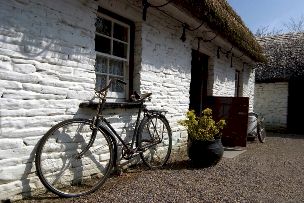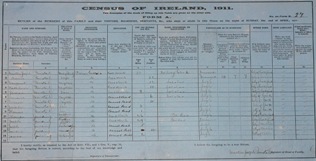- Home ›
- Irish Census ›
- 1911 Census of Ireland
Ireland's free census records are online
The 1911 Census of Ireland has
been digitised and is free to search and view
The 1911 Census of Ireland has
been digitised and is free to both search and view
Free census records for all 32 counties of Ireland went online on 28 August 2009 at the website of the National Archives of Ireland.


The launch of these records delighted Irish genealogy researchers across the world because although they had been available to the public on microfilm since 1961, accessibililty was limited to the National Archives, Family History Centers (run by the Church of Latter Day Saints), and a small number of major international libraries.
They may have been free census records but they were, to a huge number of family historians, pretty much inaccessible.
With the online launch of these free census records, this is no longer an issue to anyone with Internet access. And unlike the old microfilms, the online version is fully indexed and searchable under all fields of data - a major step forward.
Specifics of the 1911 census of Ireland
The all-Ireland census was taken on 2nd April 1911.
Form A: This household return was completed and signed by the head of household. Only the people staying in each household on the census date are included so members of the family visiting friends, travelling, or working away from their home will not be found with their family. This has been the reason many Irish family history researchers have previously failed to find individual ancestors when searching the microfilms.
The digitised returns solve this problem because they are indexed by both location and name.
Download a free blank Form A for the 1911 census of Ireland.
You can then record your ancestors' details straight from the National Archives's site, rather than print the on-screen images.
You'll save printing ink!
The information demanded for each individual was: name, age, sex, relationship to head of household, marital status, occupation, literacy level, religion, and county of birth (or country, if born outside Ireland).
An individual's ability to speak Irish was also recorded and a number of disabilities were also crudely noted on the form: deaf, dumb, blind, idiot, imbecile and lunatic.
Three significant additional questions were asked of married women: the number of years they had been married to their current husband, the number of children (born alive) they had had, and the number still living.
This information is extremely useful to genealogists as it can prove or disprove the birth or death of additional individuals in your family tree.
The Forristal family of Dublin, 1911
On Sunday 2nd April 1911, fourteen people stayed the night at the home of Martin and Annie Forristal in Nottingham Street, Dublin.
The Form A Household return shows that the couple, originally from Waterford, had been married for 13 years (Annie would have been only 18) and had had seven children, all of whom had survived infancy.
It appears that Martin, a Railway Clerk, moved the family to Dublin in 1905/6. Their seven children were Margaret, Kathleen, James, Annie, Ellen, Joseph and Thomas.
Living with the Forristals were Thomas and Joseph Goulding. Both bakers, they are probably Annie's brothers. Joseph was a recent widower with three young children so it seems a pragmatic decision had been taken to move in with his sister and her family.
Click on the thumbnail above to view the return. (The image is reproduced with the kind permission of the National Archives of Ireland.)
The all-Ireland census was taken on 2nd April 1911.
Form A: This household return was completed and signed by the head of household. Only the people staying in each household on the census date are included so members of the family visiting friends, travelling, or working away from their home will not be found with their family. This has been the reason many Irish family history researchers have previously failed to find individual ancestors when searching the microfilms.
The Forristal family of Dublin, 1911
 Click to view full size return. Image reproduced with the permission of National Archives of Ireland
Click to view full size return. Image reproduced with the permission of National Archives of Ireland
On Sunday 2nd April 1911, fourteen people stayed the night at the home of Martin and Annie Forristal in Nottingham Street, Dublin.
The Form A Household return shows that the couple, originally from Waterford, had been married for 13 years (Annie would have been only 18) and had had seven children, all of whom had survived infancy.
It appears that Martin, a Railway Clerk, moved the family to Dublin in 1905/6. Their seven children were Margaret, Kathleen, James, Annie, Ellen, Joseph and Thomas.
Living with the Forristals were Thomas and Joseph Goulding. Both bakers, they are probably Annie's brothers. Joseph was a recent widower with three young children so it seems a pragmatic decision had been taken to move in with his sister and her family.
Click on the thumbnail above to view the return. (The image is reproduced with the kind permission of the National Archives of Ireland.)
The digitised returns solve this problem because they are indexed by both location and name.
The information demanded for each individual was: name, age, sex, relationship to head of household, marital status, occupation, literacy level, religion, and county of birth (or country, if born outside Ireland).
An individual's ability to speak Irish was also recorded and a number of disabilities were also crudely noted on the form: deaf, dumb, blind, idiot, imbecile and lunatic.
Three significant additional questions were asked of married women: the number of years they had been married to their current husband, the number of children (born alive) they had had, and the number still living.
This information is extremely useful to genealogists as it can prove or disprove the birth or death of additional individuals in your family tree.
Form B1: This is the House and Building Return and, as its name suggests, it gives details of the kinds of buildings (ie shop, private dwelling etc) in the townland or street. It also records the 'class' of building, how many people lived in each dwelling, and how many rooms each dwelling contained. This form was completed by the Enumerator.
Form B2: This is the Return of Out-Offices and Farm-Steadings and gives details of the outbuildings (piggeries, cow sheds, stables, dairies, barns etc) are included with each dwelling. This form was completed by the Enumerator.
Form N: The Enumerator's abstract. This form gives a breakdown of the number of homes in a townland or street and records the number of men and the number of women who live in them. Religious denominations per house are also recorded.
See the right hand column for details of other forms used in the 1911 Irish census.
The value of the 1911 census
For nearly all researchers, the arrival of the 1911 census online will be of enormous benefit. Don't rule it out just because your ancestors had left Ireland before 1911. There may well be other family members grandparents, parents, siblings who remained at home and who you might find in the returns.
While the recorded age of each person listed in the 1901 census was often incorrect, the introduction of old-age pensions in 1908 (and its requirement for documentary proof of age) led people to be rather more careful about giving their correct age.
Free census records
Online access to Ireland's free census records makes family history research easier for more than 70 million people of Irish descent around the world.
As such, this census may help you pin down a baptismal record or civil birth registration simply by narrowing down the range of years you ought to check.
Similarly, the requirement for married women to state how long they had been married and how many children they had had (and how many survived) could help you to pin down a record of a wedding ceremony, either in the parish registers or in civil registers, and save you wasting time trying to research the adult life of a child that did not survive infancy.
Free census records
Online access to Ireland's free census records makes family history research easier for more than 70 million people of Irish descent around the world.
Where next?
- Search the 1911 census of Ireland at the NAI website
- Read the latest news about the digitisation of free census records for Ireland
- Find out more about the Irish census 1901
- Return to the main Irish census records page
- Search the 1911 census of Ireland at the NAI website
- Read the latest news about the digitisation of free census records for Ireland
- Find out more about the Irish census 1901
- Return to the main Irish census records page
- See below for details of the other types of forms used in 1911
Other Forms used in the 1911 census of Ireland
A number of additional forms were available to the Enumerator for completion when recording the occupants of institutions (ie hospitals, barracks etc.)
Often, only the initials of occupants of institutions are recorded but it may be possible to identify individuals from other recorded data such as occupation, age etc.
There was also a separate form for recording the people onboard ships in harbour or port.
These forms were:
Form B3 - Shipping return
Form C - Return of the sick in their own homes
Form D - Return of Idiots and Lunatics not in Institutions
Form E - Workhouse return
Form F - Hospital return
Form G - College and Boarding School return
Form H - Barracks return
Form I - Return of Idiots and Lunatics in Institutions
Form K - Prison return
